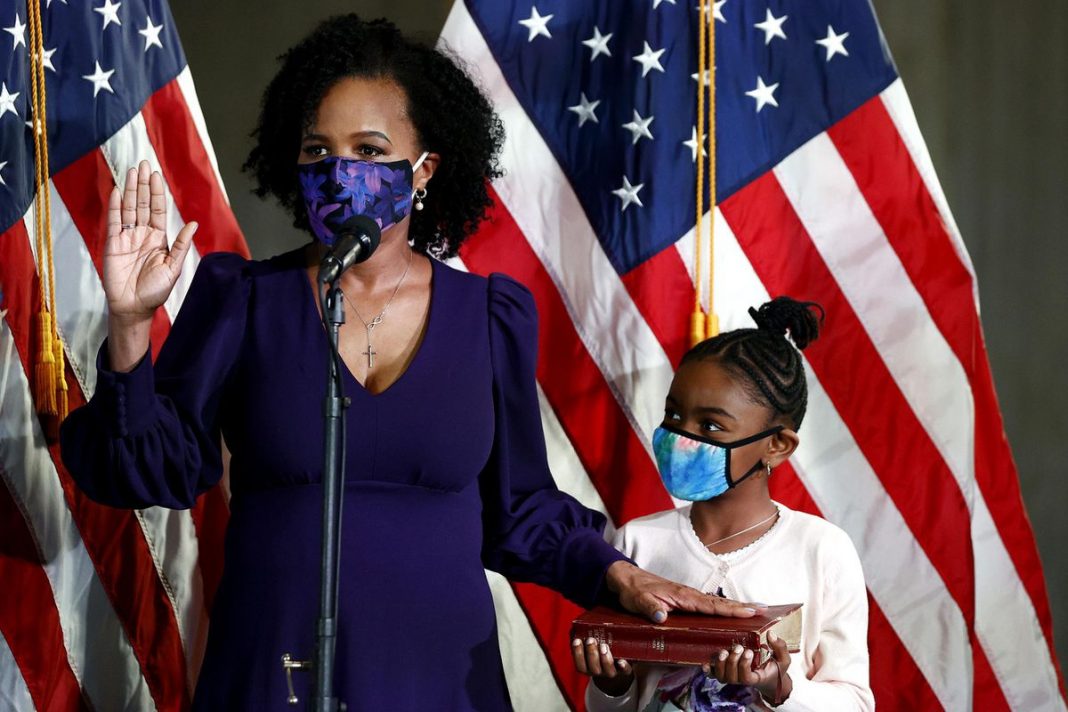
BOSTON, MASSACHUSETTS – MARCH 24: Mayor Kim Janey is sworn in as the Mayor of Boston, next to her … [+]
Getty Images
In the United States, the power of authority over local governance belongs to the states. As such, municipalities throughout the country function in different ways, with considerable variance seen across power distribution models, election protocols and even language used to name and define governmental entities. Despite these structural and procedural distinctions, there’s one now-evident constant: local politics is largely being left up to men.
Due to the expansive list of incorporated cities and townships across the country—19,500 at the last count—much of the data aimed at benchmarking gender-based representation in politics has understandably been conducted at the state and federal levels. A recent study from Rutger University’s Center for American Women and Politics (CAWP) is now shedding light on the demographics of politics at the local level. The center’s first-of-its-kind study focused on incorporated cities and towns with populations over 10,000 as per the U.S. Census. It found that currently, women hold just 30.5% of positions in mayoral offices, city councils or similar municipal bodies throughout the country.
The numbers are remarkably in line with those seen at the state leadership level, where women hold 30.9% of seats in state legislatures. The federal level reflects a similar breakdown as well, with women currently accounting for 26.5% of the membership of the U.S. Congress. At present, women comprise 50.8% of the U.S. population.
“The ‘conventional wisdom’ has been if we just go further down the ballot, to local office, we will find women doing much better,” explained CAWP Director Debbie Walsh. “The thinking was that women would be more likely to run for and win offices that allowed them to live at home while serving and required cost less to run. We questioned the veracity of this assumption, so we did a deeper dive,” she continued.
Walsh says these findings put to rest these long-held assumptions and point toward a wider and more urgent need for gender parity in positions of power. “This data already fundamentally shifts our understanding of women’s political representation in America. There isn’t some magical level of office where women have equitable representation. They’re underrepresented at similar rates at every level,” emphasized Walsh.
The study also assigns a rank to each state. Coming in at the top of the list for the highest average representation of women is Hawaii with 50%, Alaska with 46% and Colorado with 44.4%. Notably, though, there are considerable differences across state lines regarding the number of municipalities that met the 10,000 population threshold used in the study. While California counts 394 such cities and townships included in the study, only Honolulu was benchmarked in Hawaii, meaning its claim to the top spot on the list is based on a single data point. At the bottom of the list is Indiana with a 20.9% average, Mississippi at 19% and Nebraska with just 17.7%.
Within state lines, some interesting parallels can be made between municipal and state legislature data. Colorado comes in at second for women in state legislatures with 46% representation and third for women in municipal office at 44.4%. Mississippi sits at the 48th spot for seeing women in state legislatures with only 16.1% and ranks 49th for women in municipal offices with 19%. Other states show more variation between the two datasets. While Nebraska finishes last at the local level with an average of only 17.7% women, it fares somewhat better on the state legislature list coming in at number 35 with a 26.5% average.
“Data is an essential tool for diagnosing the representativeness of our political system,” said CAWP Data Services Manager Chelsea Hill. “And now, thankfully, we have the evidence to show there’s a great deal of room for improvement when it comes to women in local office.” The CAWP plans to continue tracking women in municipal office and says it will update its reporting on an annual basis.




